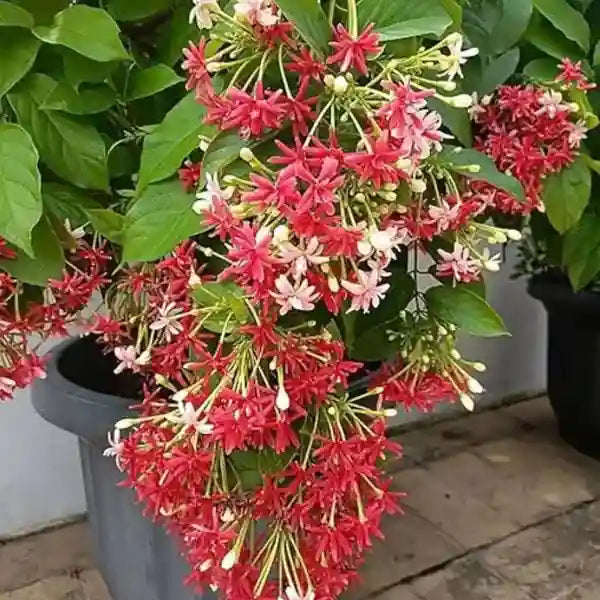Madhumalati Rangoon Creeper Double Petal Plant - Shrub Type
- Rs. 449.00
-
Regular price
Rs. 1,499.00 -
-70%
- Will be in stock after
Couldn't load pickup availability
Spend Rs 1499 for free shipping
Guarantee safe checkout


Madhumalati Rangoon Creeper Double Petal Plant - Shrub Type
Selling Size : Single Plant | Pot Included | Secure Packing
The "Madhumalati Rangoon Creeper Double Petal Plant - Shrub Type" refers to a specific variety of Combretum indicum (also known as Quisqualis indica), which is typically a vigorous climbing vine. However, it can be trained and pruned to grow as a shrub. This double-petal variety is highly sought after for its fuller, more ruffled flowers that change color from white to pink to deep red, and its strong, sweet fragrance, especially in the evening. Given you're in India, the climate is generally very suitable for this plant.
Here's a comprehensive care guide for the shrub-type Madhumalati Double Petal:
1. Light:
Full Sun is Essential for Best Flowering: Madhumalati thrives and blooms most profusely in full sunlight, meaning at least 6-8 hours of direct sun per day.
Partial Sun: While it can tolerate partial sun, flowering may be reduced, and the plant might become leggy. Ensure it still gets at least 4-6 hours of sunlight if grown in partial sun.
2. Watering:
Regular and Consistent: Water regularly, keeping the soil consistently moist but never waterlogged.
Deep Watering: Water deeply to encourage a strong root system. In hot Indian summers, you might need to water daily, especially for potted plants.
Reduce in Winter: Reduce watering during the cooler winter months when the plant's growth slows down. Allow the top inch or two of soil to dry out between waterings in this period.
Drainage: Good drainage is crucial to prevent root rot. Ensure pots have ample drainage holes.
3. Soil:
Well-Draining and Fertile: Madhumalati prefers well-draining, loamy soil that is rich in organic matter.
Soil Mix: A good potting mix for containers would be a blend of garden soil, compost/well-rotted farmyard manure (FYM), and sand or perlite to enhance drainage. Vermicompost is also an excellent addition.
pH: It generally prefers a slightly acidic to neutral pH (around 6.0-7.5).
4. Temperature and Humidity:
Warm and Humid: Being a tropical plant, it thrives in warm and humid climates, which are prevalent in much of India. Ideal temperatures range from 15°C to 40°C.
Frost Sensitivity: It is sensitive to frost. In regions with very cold winters or frost, the plant may suffer damage or die back. If temperatures drop below 10°C, provide protection (mulch, cover, or bring potted plants indoors if feasible).
5. Fertilizing:
Regular Feeding for Abundant Blooms: Madhumalati is a moderate to heavy feeder, especially during its active growing and flowering seasons.
Growing Season (Spring to Monsoon):
Organic Fertilizers: Cow dung manure, vermicompost, and fish amino acid are excellent organic options. Apply well-rotted cow dung manure or vermicompost every 15-20 days or once a month.
Chemical Fertilizers: A balanced NPK fertilizer (e.g., 10-10-10 or 19-19-19) applied once a month can be beneficial. Many recommend a phosphorus-rich fertilizer (higher middle number, e.g., 5-10-10 or 10-30-20) during the blooming season to encourage more flowers.
Reduce in Winter: Reduce or stop fertilizing during the cooler, dormant period.
Avoid Over-fertilization: Too much nitrogen can lead to excessive leafy growth at the expense of flowers.
6. Pruning (Crucial for Shrub Type):
Purpose: Since you want a "shrub type," regular and strategic pruning is paramount to control its naturally vining habit and maintain a bushy, compact form.
Timing:
Major Pruning: The best time for major pruning is in late winter or early spring, before new growth emerges. This is when the plant is dormant.
Throughout the Year: Light pruning and shaping can be done throughout the active growing season.
Techniques:
Pinch Back Young Shoots: Regularly pinch back the tips of young, vigorous shoots to encourage side branching and a bushier habit.
Remove Old/Spent Growth: Trim back any long, leggy stems that are detracting from the shrub shape. Remove dead, diseased, or weak branches.
Maintain Shape: Continuously prune to maintain the desired shrub size and shape. You can cut back stems by up to one-third or even more if you need to drastically reduce its size.
Remove Suckers: Remove any suckers that might emerge from the base of the plant, as these are usually from the rootstock or are strong vining shoots that will disrupt the shrub form.
Encouraging Blooms: Pruning encourages new growth, and Madhumalati blooms on new wood, so regular trimming helps promote more flowers.
7. Pests and Diseases:
Generally Resilient: Madhumalati is relatively resistant to major pests and diseases.
Common Pests: Occasionally, it may be affected by aphids, mealybugs, or caterpillars.
Treatment: For minor infestations, use a strong jet of water to dislodge them or apply a neem oil spray. For more severe cases, use an appropriate organic or mild chemical insecticide.
Overwatering Issues: The main disease concern is often related to overwatering, which can lead to root rot. Ensure good drainage to prevent this.
8. Support (if grown in a pot or to guide shape):
Even as a shrub type, if it's in a pot or you want a very upright, compact form, some initial staking or light support might be beneficial, especially for younger plants.
By diligently following these care practices, particularly the pruning, your double-petal Madhumalati will flourish as a beautiful, fragrant shrub in your Indian garden.
